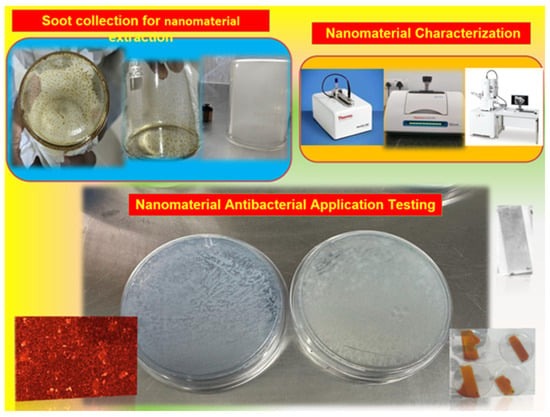1. Introduction
With benefits like chemical inertness, low toxicity, functionalization, and resistance to photobleaching, carbon nanodots (CNDs) have been put to extensive use in diverse fields, such as tissue engineering, gene therapy, wound healing, cancer treatment, bioimaging, biosensors, and photothermal cancer therapy. The family Styracaceae is where the tree
Styrax benzoin, which is the source of benzoin resin, belongs to. There are more than 150 species under the genus
Styrax. The fragrant resin that this tree produces is burned as incense in various ceremonies, especially in Asian rites. When physically damaged, the resins are expelled from the trunks and barks of
Styrax spp. [
1,
2]. These resins start off yellowish but eventually turn reddish-brown as they thicken and solidify.
Although benzoin resin’s historical use in fragrance and incense manufacturing is well known, it has also obtained its own reputation from the medicinal context. The substance is versatile, as seen by its usage in over-the-counter medications as a mild yet effective antiseptic. Cuts, wounds, sores, and abrasions on the skin may all be effectively cleaned with it, whether it is prepared as an alcoholic solution or as a benzoin tincture. Because of its bactericidal, germicidal, antiviral, and fungicidal qualities, benzoin resin smoke, also known as “Sambrani”, has been popularly used for a very long time. Being a natural product, benzoin resin has been intuitively acknowledged and accepted in various cultural and medical traditions for decades.
Currently, antimicrobial resistance (AMR) threatens successful treatment of infectious diseases across the globe [
3]. Uncontrolled prescription of antimicrobials, as well as their use in agriculture, results in the spread of AMR. Scientific and economic challenges have brought about a steady decline in the pipeline of new drugs [
4,
5]. For counteracting the lack of new antibacterials and combating the phenomenon of antibiotic resistance, plants apparently seem to offer a potentially better solution. Plants are equipped with secondary metabolites in order to cater to their defense against pests and pathogens. Throughout history, people have looked up to plants as a source of medicine; in many geographical locations of the developing world, people continue to rely on plants as the primary form of medicine, with several countries integrating traditional plant-based medicines through regulations into mainstream healthcare systems [
6,
7,
8]. The burning of plant/plant parts to release their volatile components for harnessing their medicinal attributes results in medicinal smoke, which has been gaining paramount interest [
9]. The antimicrobial effect of this medicinal smoke has been demonstrated [
10].
Apart from the pathogenic aspects of microbes, microbes are also involved in various dental problems; common oral bacterial strains, including
Porphyromonas gingivalis and
Streptococcus mutans [
11,
12], have proven to be problematic. Biofilms, where colonies of microbes become embedded in an extracellular polymeric matrix on various surfaces, are a grave problem when it comes to dental caries, medical implants, and industrial equipment (biofouling). Coliforms, such as
Escherichia coli (
E. coli), are well-known for causing food- and waterborne illnesses, necessitating the employment of efficient countermeasures [
13,
14].
CDs are nanoparticles smaller than ≈10 nm, typically composed of carbon, oxygen, nitrogen, and hydrogen. Their most important hallmark is bright fluorescence, tunable across the visible range, which has revolutionized the traditional paradigm of carbon as a black material unable to emit light [
15]. Their luminescence is accompanied by many additional benefits, such as low cost, ease of synthesis, high water solubility, biocompatibility, non-toxicity, high sensitivity to the external environment, and marked electron-donating and -accepting capabilities. From a structural viewpoint, CDs are a relatively wide family of nanomaterials with a range of possible structures and variable optical properties. Their morphology is mostly quasi-spherical, and the structure can be graphitic [
16], amorphous [
17], or characterized by a C3 N4 crystalline core [
18,
19,
20]. Ray et al. have reported the successful extraction of CNDs from smoke and have characterized the nanomaterial [
21].
The objective of the present work was to isolate CNDs from benzoin resin smoke and characterize the extracted nanomaterial. The antibacterial credentials of the extracted CNDs was proven against coliforms and oral bacteria. The benzoin resin-extracted CNDs were then used to make coatings on glass, and the antibiofilm activity of these coatings was demonstrated. This study is the first investigation in this direction.
2. Materials and Methods
2.1. Collection of Turmeric Soot
Benzoin resin was sourced from a nearby provision store and ignited, with the resulting smoke collected in a glass beaker. This process was repeated multiple times to gather highly concentrated soot. The accumulated benzoin resin soot (BRS) was then transferred from the beaker by subjecting it to ultrasonication for 10 min in 50 milliliters of sterile water. The suspended carbon from the BRS was subsequently extracted by centrifuging the mixture at 10,000 rpm for 10 min [
8,
22]. The supernatant, containing the benzoin resin-derived carbon nanodots (BRS-CNDs), was collected and stored for further experimentation.
2.2. Characterization of the BRS-CNDs
The morphology and size distribution of the BRS-CNDs were examined using a scanning electron microscope (JSM –IT800 NANO SEM). The particle size distribution of the various NPs was obtained using OPTIMAS 6.1 software based on the SEM images. A UV-visible spectrophotometer (Thermo Fisher Scientific, Waltham, MA, USA, NanoDrop Lite Plus UV) was employed to assess the optical properties and absorbance of the BRS-CNDs. Fourier-transform infrared spectroscopy (FTIR) (Bruker, Billerica, MA, USA, Compact FT-IR Spectrometer ALPHA II) was utilized to identify the functional groups and chemical composition of the BRS-CNDs.
2.3. Anti-Coliform Assay
The effectiveness of BRS-CNDs against coliform bacteria, specifically
E. coli and
Enterococcus faecalis, was evaluated. Various concentrations of BRS-CNDs were administered to cultures of
E. coli and
E. faecalis, which were then incubated overnight at 37 °C. The total viable count (TVC) of the coliform bacteria after exposure to BRS-CNDs was determined using the plate count method on nutrient agar, and results were expressed as colony-forming units per milliliter (cfu/mL) [
23]. The reported data represent the average value plus or minus the standard deviation, based on three independent experiments. Statistical analysis was performed using IBM SPSS for Windows version 12.0 (SPSS Inc., Chicago, IL, USA). A one-way analysis of variance (ANOVA) with Duncan’s multiple-range test was used to determine the statistical significance of multiple comparisons.
p-values of less than 0.05, 0.01, and 0.001 were considered statistically significant.
2.4. Anti-Oral Bacterial Assay
The effectiveness of the extracted BRS-CNDs against oral bacteria was evaluated. Oral samples were collected from a human volunteer (one of the authors). Samples were collected using a sterile brush and suspended in 20 mL phosphate buffer and stored in the refrigerator in 50 mL falcon tubes. Samples were collected on three consecutive mornings and labeled OS1, OS2, and OS3.
An antibacterial assay was conducted by adding various concentrations of carbon nanomaterial (100 uL, 500 uL, and 1000 uL) to 10 mL aliquots of OS1, OS2, and OS3. Following carbon nanomaterial interaction overnight in a shaker cum incubator, the surviving bacteria were enumerated using the TVC method by plating on Mitis Salivarius Agar Base (HiMedia M259). After 48 h the colonies were counted, and the total viable bacteria were calculated using standard microbiological formulae.
2.5. Anti-Biofilm Assay
Nanocoatings of carbon were created on glass surfaces by submerging them in a BRS-CND solution for 24 h. After removal, the glass slides were dried in a hot air oven overnight. To grow biofilm, the carbon-coated slides were immersed in nutrient broth cultures of
Staphylococcus aureus and incubated for 24 h. The slides were then gently rinsed in sterile water to eliminate loosely attached biofilm components. A 0.1% acridine orange fluorescent dye was applied to the biofilm, incubated for 2 min, washed off, and air-dried. The biofilm on both coated and uncoated glass surfaces was observed using an Olympus CKX53 fluorescence microscope, with the orange fluorescing cells indicating actively metabolizing cells [
23]. The fluorescence emitted by the cells was quantified using ImageJ software (Version 1.45k). Five areas on each surface were imaged, and the average values from three samples are reported here.
Figure 1 gives the overall scheme behind the workflow of this study.
4. Discussion
The results of the investigation showed how effective the BRS-CNDs were against coliform bacteria, especially against
E. faecalis. The results further demonstrated the successful inhibition of oral bacteria by BRS-CNDs. Strong antibiofilm activity was also shown by the carbon coatings that were made from the BRS-CNDs. These findings support the anti-bactericidal properties of the benzoin resin smoke extracted carbon nanodots. These findings suggest that carbon nanoparticles derived from benzoin smoke may find application as potent antimicrobials. The antibacterial properties of medicinal smoke have been documented by earlier writers [
9,
10,
25]. Airborne microbes were reported to be significantly decreased on exposure to medicinal smoke. Chun et al. [
26] have documented the antimicrobial properties of CNDs extracted from turmeric smoke [
26]. To pinpoint the exact mechanisms by which these CNDs function as antibacterial agents, more investigation is required. Nonetheless, it is reported that the mechanism of antibacterial activity of CNDs is usually via the rupturing of bacterial cell membranes, with eventual interaction with the cellular organelles and metabolic activity through reactive oxygen species (ROS) production.
Figure 8 gives the speculated scheme showing the plausible mechanism behind the antibacterial activity of BRS-CNDs based on published reports [
26].
BRS-CNDs probably have antibacterial qualities because they are functionalized with the volatile bioactive components of benzoin resin. The functionalization of bioactive chemicals derived from turmeric on carbon nanodots was verified by our previous investigation [
26]. Vanillin, cinnamic acid, benzaldehyde, benzoic acid, and benzyl benzoate are the main ingredients of
Styrax benzoin [
27]. The chemicals found in
styrax benzoin, such as benzyl benzoate, benzaldehyde, and benzoic acid, have fungicidal, bactericidal, and germicidal properties [
28]. The antibacterial activity of carbon nanomaterials is well documented by diverse authors as well [
29,
30,
31]; what is lacking is mechanistic studies as well as in vivo studies with life cycle assessments of these nanomaterials.
Our group has previously isolated carbon nanodots from turmeric smoke to create coatings on glass [
24]. The smoke-extracted carbon nanodots provide antibiofilm coatings that are economic, cost-effective, and obtained via a simple and straightforward energy-efficient technique. This is the first investigation in this direction; more research in this area may produce authoritative answers that meet the sustainability mandate.


